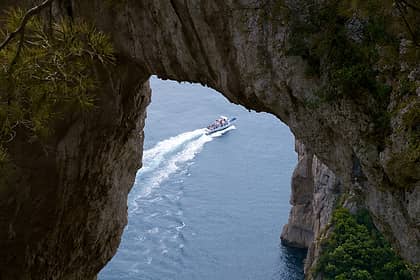Pizzolungo





There's a place in Capri where the island's glamorous social whirl comes to a grinding halt and nature starts to reclaim center stage: at the end of the boutique-lined Via Camerelle, where Via Tragara begins.
Lined with luxury hotels and villas, of which passers-by can catch only a glimpse amidst the lush vegetation which screens the properties from indiscreet eyes, Via Tragara is home to the German Evangelical Church; Villa Discopoli, residence of the writer Rainer Maria Rilke; Villa Lo Studio where the poet Pablo Neruda stayed, and Hotel Punta Tragara, said to have been designed, if only in part, by the architect Le Corbusier.
Via Tragara terminates in a large terrace with fabulous view over the Faraglioni rocks. To the left one can glimpse, across the waters, a part of the Amalfi Coast whilst, to the right, there are houses clinging miraculously to the slopes, the castle-topped Monte Castiglione, Monte Solaro and the bay of Marina Piccola.
Pizzolungo
Pizzolungo
From the Tragara viewing point, a little pathway skirts round the right hand side of the terrace, to join the Pizzolungo: footpath which traces the coastline all the way to the Natural Arch.
Pizzolungo is one of the most beautiful walks on the island of Capri. Extremely pleasant throughout the summer, the walk is especially spectacular in winter, when the strong winds and stormy seas paint the land and seascapes with colors which have bewitched any number of artists.
The route proceeds until meeting a narrow and extremely steep flight of steps which leads to the Grotta di Matermania. Scholars have attributed the cult rituals which were performed in the cave to the divinities Mitra or Cibele, goddess of fertility. After the cave there are another 200 steps to climb before arriving at the Natural Arch.
Natural Arch
Natural Arch
The Natural Arch, an extraordinary Paleolithic sculpture, is all that remains of a deep and incredibly high cavity of underground origin, which was discovered in the aftermath of a landslide. The incoherent nature of the rock has determined the continuing corrosion of the stone, leaving a 12 meter wide section of the vault suspended roughly 18 meters above the ground, which forms a natural bridge between the two pillars of rock. The Natural Arch is elevated high above sea level and its semicircular opening provides the perfect picture frame for the spectacular sea scenery in the distance.
The Natural Arch is also visible from the sea during one of the boat tours that circle the island, offering a unique and enchanting perspective of this natural wonder.
Grotta di Matermania
The cave is most often called the Grotta di Matermania although its is also known as the Grotta del Matrimonio or di Matrimonia. It is formed by a cavity roughly 30 meters long and 20 meters wide, with a median height of 10 meters. From the remains found within its interior it is not clear to which divinity the cave was dedicated in ancient times, although its use as a sacred place is certain. It is believed that the cult of the god Mitra might possibly have been practiced here, the associated rituals of which were almost always carried out in caves; or that of Cibele, goddess of nature, of animals and wild places.
In the Roman period, the Grotta di Matermania was transformed in to a luxurious nymphaeum, where the islanders met to indulge in the "pagan" pleasures of life!



FAQ - Frequently asked questions
How long does the Arco Naturale – Pizzolungo trail take?
The full loop takes around 1 hour and 30 minutes, starting from Piazza Tragara or Capri town center. The hike isn’t long but includes some steep stairs and uneven terrain. Bring water and comfortable shoes, especially in summer.
Where does the trail to the Arco Naturale start?
The trail starts from Capri’s town center, following Via Matermania uphill. After about 20 minutes, you’ll reach the impressive Arco Naturale, a limestone arch overlooking the sea. The path is clearly marked and surrounded by Mediterranean vegetation. Morning hours are best to avoid the heat.
Is the Pizzolungo trail difficult?
The Pizzolungo path includes several uneven steps and some steep sections, but it doesn’t require expert hiking skills. It’s rated as a moderate trail, ideal for regular walkers. During summer, bring a hat and take short breaks in shaded spots along the way.
Can I walk only to the Arco Naturale?
Yes, you can hike only up to the Arco Naturale and return the same way. In this case, the total walk takes about 40–45 minutes. It’s a good option for those short on time or who prefer to skip the Pizzolungo stairs. The arch offers a stunning view of the Tyrrhenian Sea.
Where does the Pizzolungo trail lead?
The Pizzolungo trail continues from the Arco Naturale along Capri’s eastern cliffs, passing the Grotta di Matermania and ending near Punta Tragara. Along the route, you’ll find scenic viewpoints overlooking the Faraglioni rocks and the Sorrento coastline.
Can I walk the trail with children?
Yes, but only with children used to walking and under close supervision. Some sections of the Pizzolungo trail have steep steps and low railings. Families with small kids should stop at the Arco Naturale and head back, skipping the coastal descent.
How far is the Arco Naturale from Capri town?
The Arco Naturale is about 2 km from Capri town. The walk takes around 20–25 minutes along a scenic route lined with villas and gardens. It’s an easy stroll, perfect for an afternoon walk.
Where are the best panoramic viewpoints?
Top viewpoints include the terrace below the Arco Naturale, the area near the Grotta di Matermania, and the overlook toward the Faraglioni rocks along the Pizzolungo trail. Each offers unique photo opportunities and peaceful rest spots.
Is the trail shaded?
Partially. Sections between Via Matermania and the Arco Naturale are shaded, while the Pizzolungo stretch is mostly sunny. During hot months, bring a hat, water, and sunscreen.